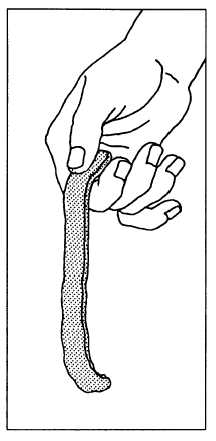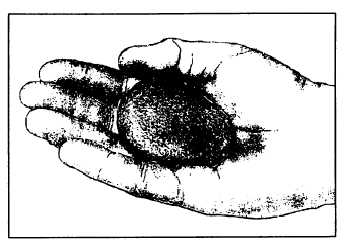Figure 16-7.-Ribbon test.
diameter is moistened with water. This sample should
be just wet enough that the soil does not stick to your
fingers upon remolding or just below the sticky limit.
For testing, the sample is then placed in the palm of
the hand and shaken vigorously. This is usually done by
jarring the hand on the table or some other firm object
or by jarring it against the other hand. The soil is said to
have given a reaction to this test if, when it is shaken,
water comes to the surface of the sample producing a
smooth, shiny appearance. This appearance is
frequently described as livery (fig. 16-8).
The sample is then squeezed between the thumb and
forefinger of the other hand. As this is done, the surface
water quickly disappears and the surface becomes dull.
The sample becomes firm, resisting deformation, and
cracks occur as pressure is continued. Finally the sample
crumbles like a brittle material.
The vibration caused by shaking the soil sample
tends to reorient the soil grains, decrease the voids, and
force water, which had been within these voids, to the
surface. Pressing the sample between the fingers tends
to disarrange the soil grains and increase the void
spaces. The water is then drawn into the soil. If the water
content is still adequate, shaking the broken pieces
Figure 16-8.-Livery appearance produced by wet-shaking test.
causes them to liquefy again and flow together, and the
complete cycle may be repeated. This process can occur
only when the solid grains are bulky in shape and
noncohesive in character. Very fine sands and silts fall
into this category and are readily identified by the
wet-shaking test. Since it is rare that fine sands and silts
occur without some amount of clay mixed with them,
there are varying degrees of reaction to this test. Even a
small amount of clay tends to retard this reaction greatly.
Some of the descriptive terms applied to the different
rates of reaction to this test are as follows:
. SUDDEN OR RAPID. A rapid reaction to the
shaking test is typical of nonplastic, fine sands and silts.
A material known as rock flour that falls into the silt-size
ranges also gives this type of reaction.
. SLUGGISH OR SLOW. A sluggish reaction
indicates slight plasticity such as might be found from
a test of some organic or inorganic silts or silts
containing a small amount of clay. Even a slight content
of colloidal clay imparts some plasticity and materially
slows up the reaction to the shaking test. Extremely slow
or no reaction is typical of all inorganic clays and of the
highly plastic organic clays.
. NO REACTION. Obtaining no reaction at all to
this test does not indicate a complete absence of silt or
fine sand.
ODOR TEST
Organic soils of the OL and OH groups usually have
a distinctive, musty, slightly offensive odor. With
experience, you can use this odor as an aid in identifying
these groups. This odor is especially apparent from fresh
samples. The odor gradually reduces when exposed to
16-19



